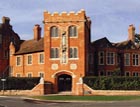Keeping the Faith
Two new developments have more claim than most to the description ‘divine’


When, in April 2002, the Benedictine nuns of Stanbrook Abbey at Callow End, near Worcester, took the agonising decision to ?downsize? from their landmark Victorian abbey, with its 79,000sq ft of monastic buildings, including an Edward Pugin church, the community had few illusions about the problems they would face. As Abbess Joanna Jamieson said: ?If moving house is like spinning plates, then moving monasteries is trying to keep satellite dishes spinning or so we have found.?
Having made the decision to move, ?to make the best use of its human and financial resources?, members of the enclosed community of 25 nuns and 120 or so lay members, looked at possible sites all over the country until, earlier this year, they bought Crief Farm at Wass in the North Yorkshire National Park.
Crief Farm was a collection of nine Scandinavian holiday lodges near the medieval ruins of Rievaulx Abbey in the midst of the North Yorkshire Moors, and for the sisters the opportunity seemed heaven sent. ?We see this as the hand of Providence,? said Abbess Joanna, adding: ?The natural beauty of the park is ideal for contemplative life, as monks and nuns of earlier centuries found before us.?
The sisters worked for months on the design of their new monastery with Bath architects Feilden Clegg Bradley (01225 852545), before submitting their plans for a new, 21st-century convent and retreat house to the North York Moors planning authority. Miraculously, their application was approved within a matter of months. With construction expected to take three years to complete, the community is now looking to Worcester based Andrew Grant (01905 734735) to find them a ?sympathetic? buyer for Stanbrook Abbey.
Residential development is the least favoured option as far as local interests are concerned, but Mr Grant hopes that the guide price of £6 million to £10m may yet attract a worthy custodian for this ?nationally important? complex of historic religious buildings. The good Lord will surely provide.
As he did, apparently, for the monks of Douai Abbey at Woolhampton, Berkshire another bastion of the English Benedictine community when they were looking to sell the buildings of the former Douai School, which closed, ?due to economic pressures?, in 1999. Following a bidding contest between a number of prospective purchasers, the 95,500sq ft former school complex was purchased by Berkshire based conservation specialists Bewley Homes.
A £28m restoration and development project, soon to be completed under the name of Avalon, sees the converted red brick buildings of Douai School blending seamlessly with a ?campus? of new houses inspired by the courts and cloisters of Winchester and Oxford, and designed by Robert Adam. Meanwhile, the monks of Douai Abbey, some of whom are still in residence, are happily planning to build themselves a new monastery on a prime site just across the road.
Sign up for the Country Life Newsletter
Exquisite houses, the beauty of Nature, and how to get the most from your life, straight to your inbox.
Avalon stands on lands donated to the local Catholic community by the Earl of Fingall when he sold his Woolhampton estate in 1786 and moved to Ireland. In 1903, a group of Benedictine monks from Douai in northern France arrived to take over the school established on the site in 1829. They continued the ambitious building programme initiated by their Victorian predecessors, adding, in 1916, the new refectory with its magnificent wooden ceiling.
In 1936, the fathers extended the quadrangle to incorporate a library with a spectacular full length window and stone fireplace, and added yet more
classrooms and dormitories. Further buildings were created over the years: all are being ingeniously converted to a total of 33 luxury apartments, currently for sale (with several already sold) through Bewley Homes (0118?971 4491) at prices ranging from £295,000 to £1m.
There is a hint of visionary zeal about Bewley Homes? founder and chairman, Colin Brooks, as he strides among the mixers and the masons, pointing out architectural features of interest or the layout of the knot-garden and the wildflower meadows. Douai or Avalon seems to have become his spiritual home, too.
This article was originally published in Country Life magazine, December 1, 2005.


For more on property, architecture, the arts and the countryside subscribe to Country Life magazine

Contact us about this story

Search all online stories

For what's in the magazine this week see contents

Sign up for our free newsletter

Country Life is unlike any other magazine: the only glossy weekly on the newsstand and the only magazine that has been guest-edited by HRH The King not once, but twice. It is a celebration of modern rural life and all its diverse joys and pleasures — that was first published in Queen Victoria's Diamond Jubilee year. Our eclectic mixture of witty and informative content — from the most up-to-date property news and commentary and a coveted glimpse inside some of the UK's best houses and gardens, to gardening, the arts and interior design, written by experts in their field — still cannot be found in print or online, anywhere else.
-
 In all its glory: One of Britain’s most striking moth species could be making a comeback
In all its glory: One of Britain’s most striking moth species could be making a comebackThe Kentish glory moth has been absent from England and Wales for around 50 years.
By Jack Watkins
-
 Could Gruber's Antiques from Paddington 2 be your new Notting Hill home?
Could Gruber's Antiques from Paddington 2 be your new Notting Hill home?It was the home of Mr Gruber and his antiques in the film, but in the real world, Alice's Antiques could be yours.
By James Fisher